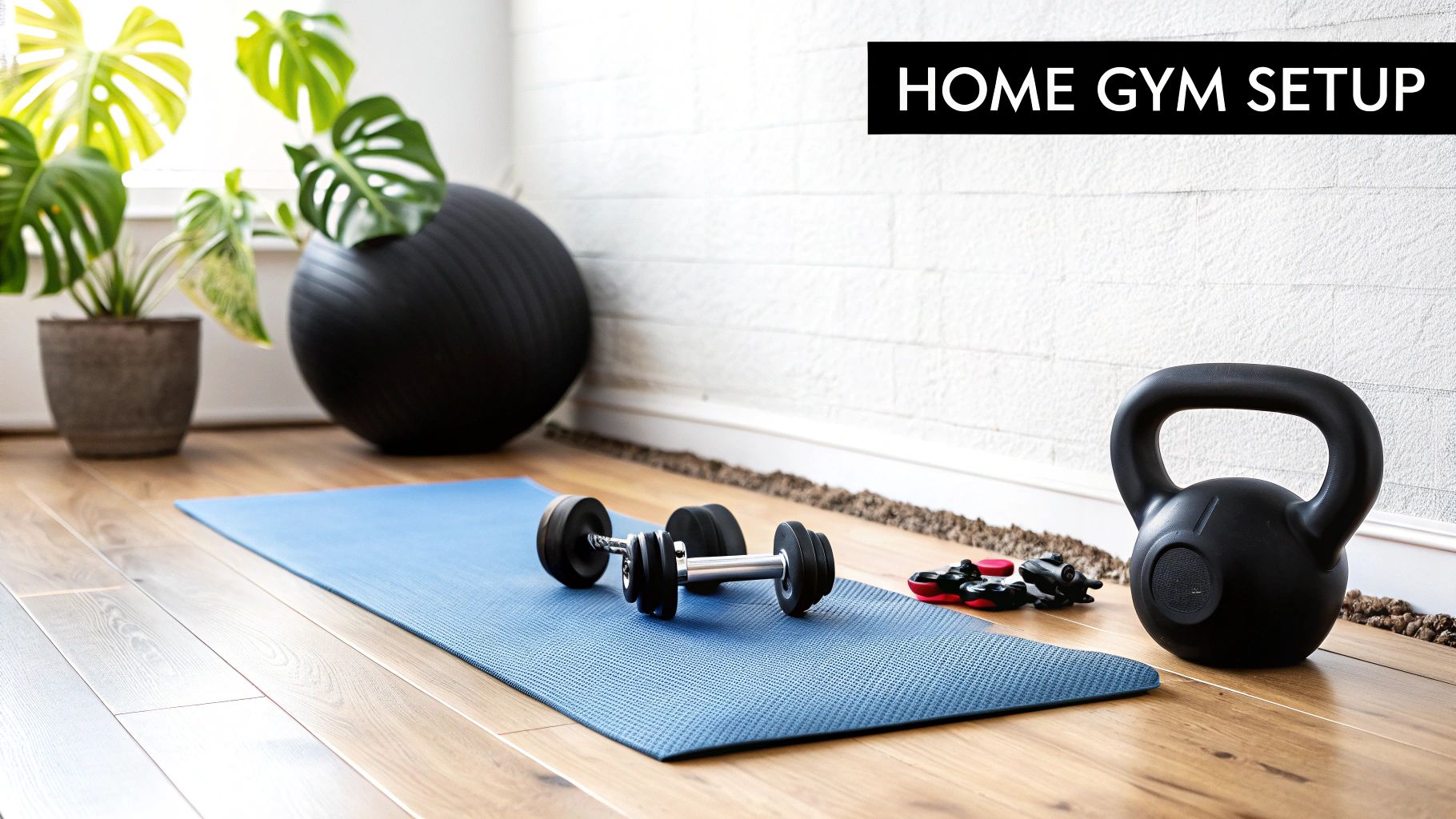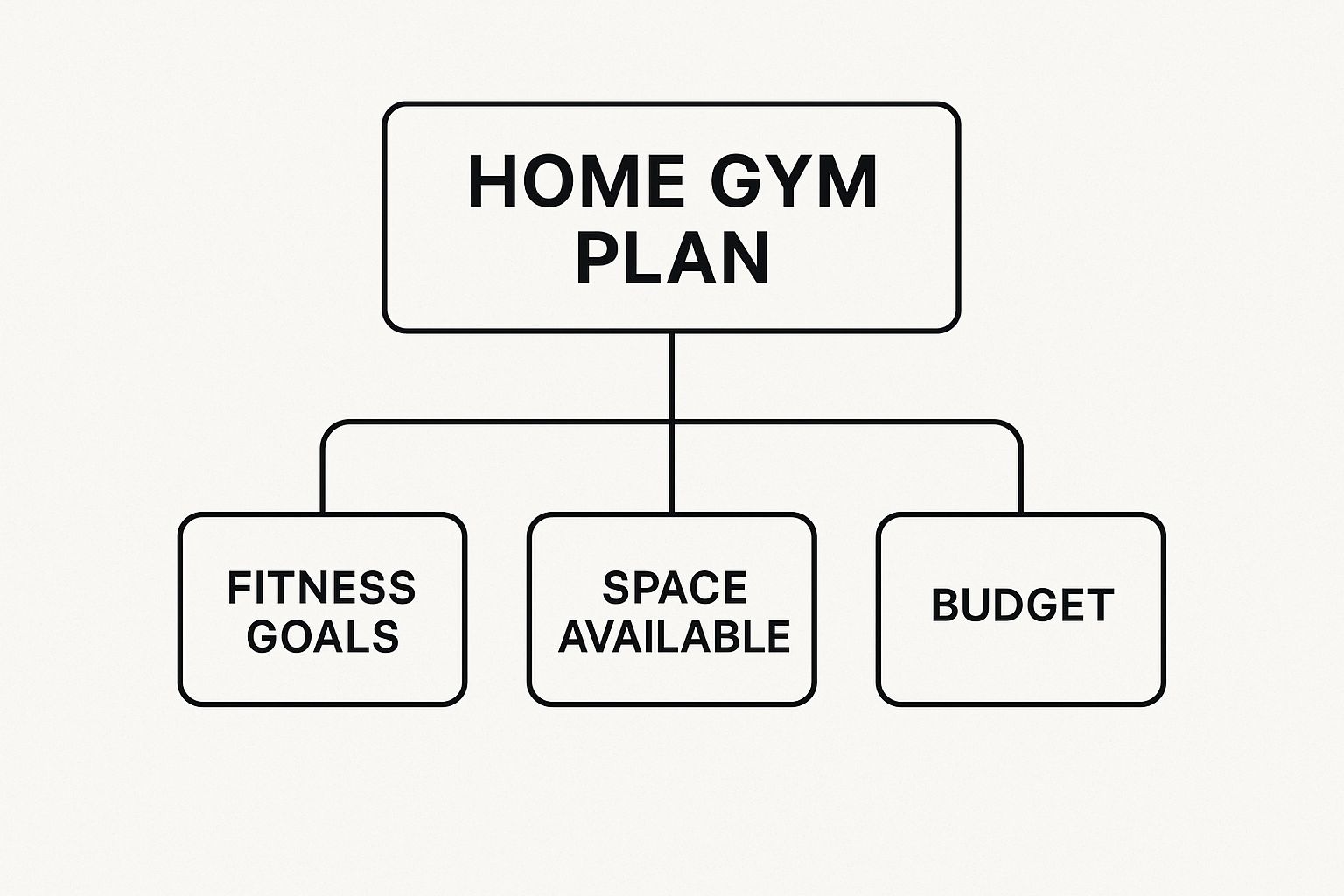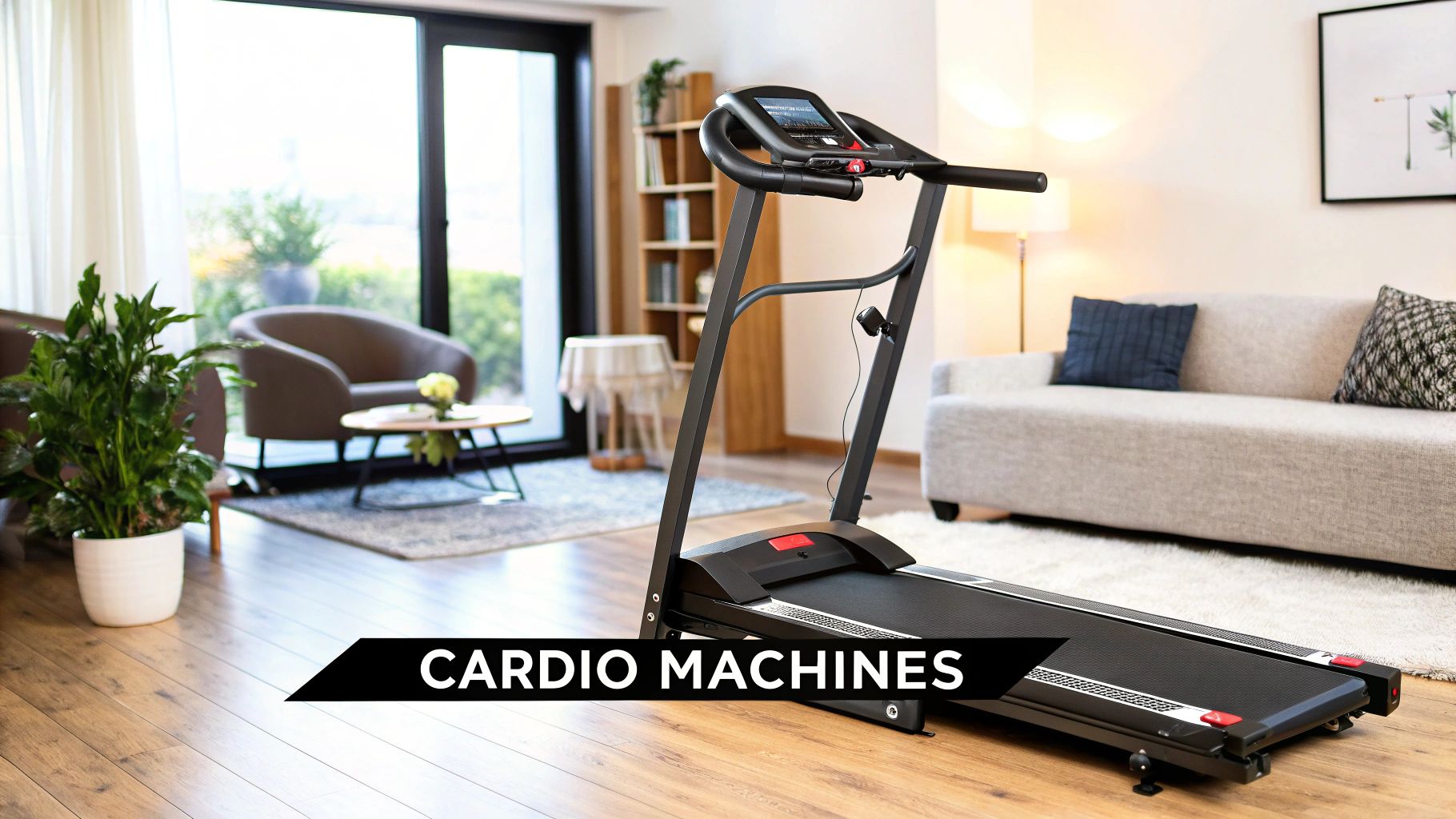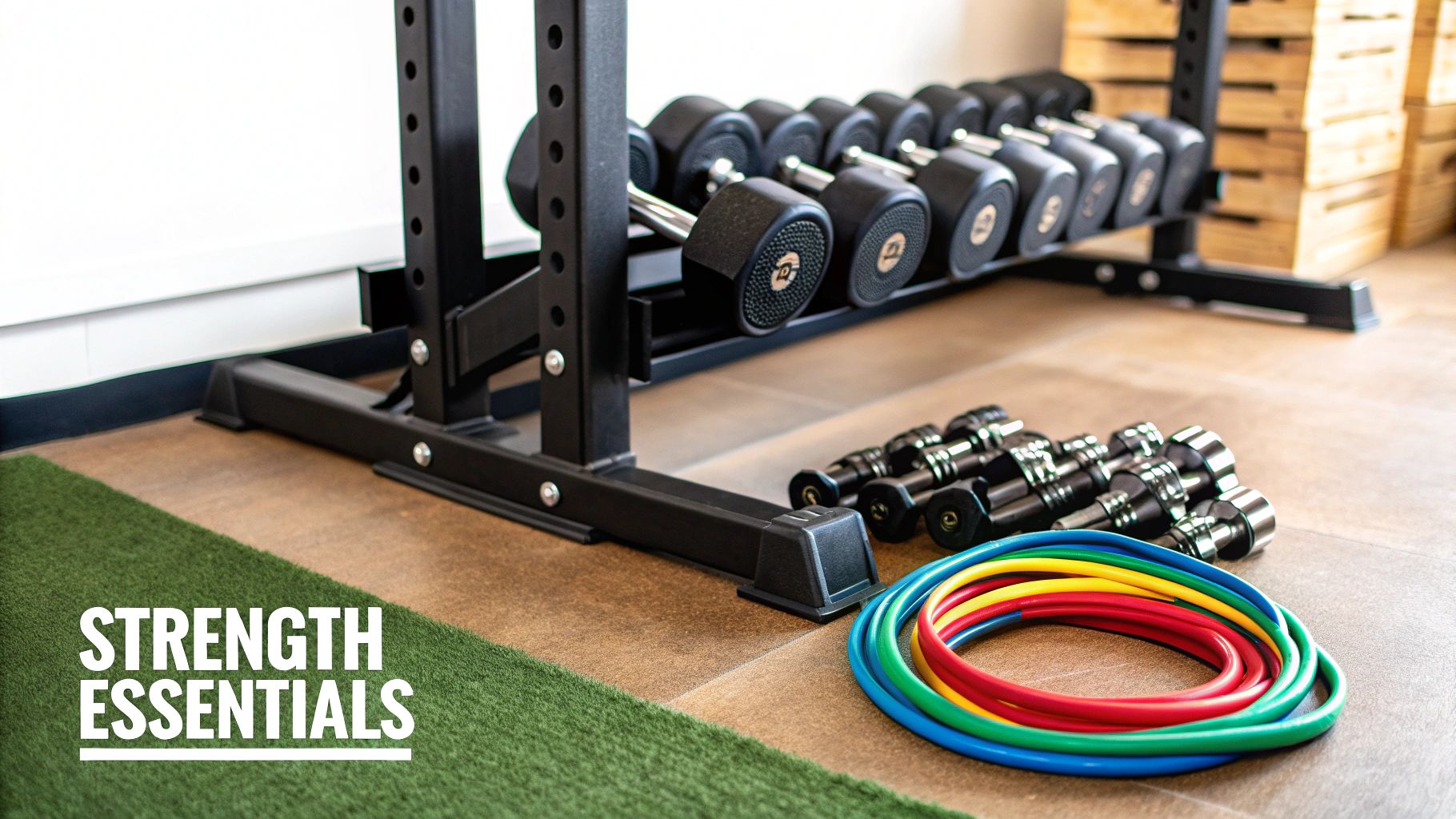
What's the best workout equipment for a home gym? Honestly, it depends entirely on your goals. But if you're looking for a versatile starting point, you can't go wrong with a set of adjustable dumbbells, some good resistance bands, and a quality workout mat. This simple trio opens the door to a huge variety of strength, cardio, and flexibility workouts without taking over your living room.
Building Your Perfect Home Gym Starts Here

Creating a home gym that you’ll actually want to use isn’t about buying the flashiest, most expensive machine. It's about making smart, personal choices that fit your fitness journey. This guide is designed to cut through the marketing hype and help you build a space that genuinely motivates you day in and day out.
Think of it like drawing up a blueprint for your house. You wouldn't just start buying lumber and hope for the best. We're going to take a strategic approach based on three core pillars, ensuring every piece you buy has a clear purpose and every dollar is an investment in your health.
The Three Pillars of a Great Home Gym
Before you even start browsing online stores, you need a plan. Let’s start by answering these foundational questions:
- What Are Your Fitness Ambitions? Are you training for a marathon and need to boost your cardio? Maybe you're focused on building raw strength, or perhaps your goal is overall wellness and flexibility. Your goals will be your guide.
- What Space Are You Working With? Get real about your available room. Do you have a dedicated spare bedroom, a tiny corner of your apartment, or a slice of the garage? Measure it out.
- What’s Your Budget? Decide what you're comfortable spending. You can create a surprisingly effective gym on a shoestring budget, or you can invest in more advanced equipment. There's no right or wrong answer.
The demand for home fitness has absolutely boomed, which means we have more choices than ever. The global at-home fitness equipment market was valued at an impressive USD 8.87 billion in 2024 and is on track to hit USD 18.03 billion by 2033. This explosion shows just how many people are looking for convenient, effective workout solutions at home. You can explore more about this market trend at Straits Research.
Your home gym doesn't need to look like a commercial facility on day one. It just needs to be functional and inviting enough to make you show up. Start small, stay consistent, and build from there.
Matching Your Space and Budget to Your Goals
Before you even start browsing for equipment, let's talk about two things that will make or break your home gym: your space and your budget. Getting this right from the start is like drawing up a blueprint before you start building. You wouldn't buy a massive, commercial-grade oven for a tiny studio apartment kitchen, right? The same logic applies here.
A little planning now prevents that all-too-common scenario where a pricey impulse buy ends up as a glorified clothes rack. We want every dollar and every square foot to count.
This simple breakdown shows the three pillars of a well-planned home gym.

As you can see, your fitness goals, the space you have, and your budget are all woven together. To get the best results, you have to consider them as a single package.
Measure Your Workout Zone
First things first, grab a tape measure. Figure out exactly where your gym will live, whether it's a dedicated spare room or just a corner of your living room. The key is to measure not just for the machine's footprint, but for the "active space" you'll need around it. You need room to swing a kettlebell, step back for a lunge, or stretch out without knocking over a lamp.
If you're working with a tight spot, think vertical. Wall-mounted storage and multi-functional gear that can be easily tucked away will be your best friends. For more great ideas, check out our guide on how to organize small spaces.
Create a Realistic Budget Framework
Next up is money. Deciding on a budget isn’t about limiting yourself; it’s about focusing your search and making smart choices. The good news is you can build a killer home gym at almost any price point.
Here’s a quick look at what you can realistically get at different levels:
- Under $300: This is your foundation. You can easily get a fantastic setup with resistance bands, a good yoga mat, a stability ball, and a kettlebell or a set of adjustable dumbbells. That’s enough to cover a huge range of strength, cardio, and flexibility workouts.
- $500 - $1,000: In this tier, you can start adding a more specialized piece to the mix. Think about a high-quality barbell and plates, a sturdy weight bench, or even a foldable cardio machine like a compact rower or treadmill.
- $1,000+: With this budget, you're looking at building a truly comprehensive home gym. This could mean a power rack for heavy and safe lifting, a full dumbbell rack, or a premium cardio machine with all the interactive bells and whistles.
This isn't just a niche hobby anymore; home fitness is a booming industry. As more people build out dedicated workout spaces, the market is growing to meet that demand. In 2021, residential construction spending in the U.S. alone hit an incredible USD 774.9 billion, a 23.2% jump from the year before. You can learn more about home fitness market trends to see just how fast things are moving.
Key Takeaway: The "perfect" home gym has nothing to do with having the most expensive gear. It’s about choosing the right tools that fit your life, your space, and your wallet—the things that will actually help you show up and get the work done.
Essential Equipment for Every Fitness Goal
The world of home workout equipment is huge, and it's easy to get overwhelmed by all the gadgets promising miracle results. Let's cut through the noise. The secret isn't buying everything; it's about matching the right tool to the right job.
Think of it like stocking a kitchen. You don't need every appliance ever made, but you do need a good knife for chopping, a pan for cooking, and maybe a blender for smoothies. Your home gym works the same way. Let's organize the gear into four simple categories based on what you want to achieve.
Cardiovascular Equipment
This is all about getting your heart pumping, building endurance, and torching calories. Cardio gear is the engine of your home gym—it’s what boosts your stamina and keeps your cardiovascular system in top shape. If you're looking to lose weight, improve heart health, or train for a 5k, this is where you start.
A few classics in this category include:
- Treadmills: The tried-and-true option for runners and walkers who want a straightforward and effective workout.
- Rowing Machines: These are fantastic for a low-impact, full-body burn that fires up over 85% of your muscles.
- Stationary Bikes: Perfect for a joint-friendly ride. You can go for high-intensity spin sessions or a more relaxed pace on a recumbent bike.
Strength Training Gear
Want to build muscle, boost your metabolism, or improve bone density? Then strength equipment is an absolute must. These are the tools that sculpt a stronger, more resilient body, and there are options for every budget and space imaginable.
Getting into strength training is easier than ever. If you're just starting out, our guide on essential home gym equipment for beginners is a great place to get your bearings.
Key Takeaway: You don't need a giant, commercial-grade machine to see results. A few smart pieces, like adjustable dumbbells or a good set of resistance bands, can deliver a seriously effective full-body workout.
Flexibility and Recovery Tools
This is the category everyone forgets, but it's the secret ingredient for long-term success. These tools help you improve your mobility, soothe sore muscles, and keep injuries at bay. Think of this as the maintenance crew for your body—keeping you tuned up and ready for your next workout.
- Yoga Mats: Gives you a clean, comfortable, non-slip surface for stretching, yoga, or any floor-based exercises.
- Foam Rollers: A game-changer for working out knots and easing muscle tightness. It’s like a deep-tissue massage you can do yourself.
- Stretching Straps: Help you safely deepen your stretches and improve your overall flexibility without overdoing it.
All-In-One Systems
For anyone short on space but big on variety, all-in-one systems are a brilliant solution. They pack a ton of functionality into a single footprint, often blending strength and cardio with digital coaching and on-demand classes. They’re perfect if you crave structure and want to get the most out of every workout without cluttering your home.
The demand for these convenient setups is exploding. The global home gym equipment market is expected to jump from USD 12.4 billion in 2025 to a massive USD 19.6 billion by 2035. It’s clear that effective, at-home fitness is here to stay, and you can discover more insights about this growing market to see where things are headed.
To make things even clearer, here's a quick cheat sheet to help you connect your fitness goals directly with the right type of equipment.
Home Gym Equipment by Fitness Goal
| Fitness Goal | Primary Equipment Category | Example Equipment | Best For |
|---|---|---|---|
| Weight Loss | Cardiovascular Equipment | Treadmill, Rowing Machine, Bike | Burning calories and improving overall endurance. |
| Muscle Building | Strength Training Gear | Dumbbells, Kettlebells, Squat Rack | Increasing lean muscle mass and boosting metabolism. |
| Improved Mobility | Flexibility & Recovery Tools | Yoga Mat, Foam Roller, Stretch Straps | Reducing muscle soreness and preventing injury. |
| Overall Fitness | All-In-One Systems | Smart Home Gym, Functional Trainer | Guided, full-body workouts in a compact space. |
Think of this table as a starting point. Most people end up mixing and matching, but knowing your primary goal helps you invest your time and money wisely from the very beginning.
Top Picks for Cardiovascular Workout Equipment

Ready to get your heart pumping and torch some calories? Cardio equipment is the cornerstone of most home gyms, and for good reason. It’s the engine that builds your endurance, boosts your stamina, and helps you smash weight loss goals.
But let's be honest, staring at a sea of options can be paralyzing. The secret is finding the machine that doesn't just fit your space and budget, but one you'll actually want to use. Let’s dive into the best cardio gear out there so you can find your perfect match.
Treadmills: The Classic Choice for Runners and Walkers
You can't go wrong with a treadmill. It's the undisputed king of straightforward cardio, giving you a controlled space to walk, jog, or go all-out in a sprint, no matter the weather. They’re a fantastic pick for pretty much any fitness level.
And forget the clunky, loud machines of the past. Today’s treadmills are packed with smart features.
- Foldable Designs: A lifesaver for small apartments. You can get your workout in and then fold it up to reclaim your living room.
- Incline and Speed Controls: These are non-negotiable. Simulating hills and changing your pace are key to keeping your body guessing and making progress.
- Interactive Screens: From guided runs with trainers to virtual trails that take you through scenic mountains, these features make your workout fly by.
If you’re training for a marathon, you’ll want a heavy-duty model with a powerful motor and a well-cushioned deck to absorb the impact. But if you’re more of a casual walker, a compact, foldable unit will give you everything you need without dominating the room.
Stationary Bikes: Low-Impact and High-Intensity
A stationary bike is your best friend if you want a killer workout without pounding on your joints. For anyone with sensitive knees or hips, or those who just prefer a smoother ride, it’s an incredible tool for powerful cardio.
You’ll generally find three types:
- Upright Bikes: These feel like a classic outdoor bike. They put you in a great position to engage your core and maintain good posture.
- Recumbent Bikes: With a laid-back seat and full back support, these are pure comfort. They're perfect for beginners or anyone managing back pain.
- Spin Bikes: Built for high-intensity interval training (HIIT), these use a heavy flywheel to deliver that smooth, challenging feel of a road bike in a high-energy class.
A spin bike is your ticket to recreating those boutique studio vibes at home. If you're looking for something more relaxed for steady-state cardio, a recumbent bike offers unmatched comfort.
Rowers and Ellipticals: The Full-Body Burn
If you want the most bang for your buck in a single workout, look no further than rowers and ellipticals. Both of these machines deliver a low-impact, full-body session that gets nearly every muscle moving.
A rowing machine is a true beast, firing up over 85% of your muscles with every single stroke. It’s a fantastic blend of cardio and strength, hitting your legs, core, back, and arms all at once. Plus, they’re surprisingly compact—many can even be stored upright.
An elliptical trainer gives you a smooth, gliding motion that’s incredibly gentle on the joints, making it a great alternative to running. The moving handlebars ensure you’re working your upper and lower body at the same time, making it one of the best pieces of workout equipment for a complete, low-impact routine at home.
The Best Strength Training Equipment for Your Home

Building real strength at home is simpler than you might think. You don't need a sprawling, commercial-sized gym to boost your metabolism, build muscle, and completely reshape your body. All you need are the right tools.
Think of this as your roadmap. We’ll start with the essentials—the versatile, space-saving gear that delivers incredible results—and then explore how to scale up when you’re ready for more. It's all about building your personal strength toolkit, one smart piece at a time.
Starting Strong with Versatility
If you're just starting out or short on space, a few key pieces of equipment can open the door to hundreds of exercises. These are the undisputed champions of the compact home gym, giving you the most bang for your buck and square footage.
- Adjustable Dumbbells: Imagine an entire rack of dumbbells squeezed into the space of just two. That's what you get here. A simple twist or click changes the weight, letting you go from light shoulder raises to heavy squats in seconds. They are a game-changer for progressive overload.
- Kettlebells: This is where strength meets cardio. Kettlebell swings, goblet squats, and Turkish get-ups are phenomenal for building explosive, functional power while sending your heart rate through the roof. It’s a full-body workout in a single cast-iron ball.
- Resistance Bands: Don't underestimate these. A quality set of bands provides variable resistance that challenges your muscles differently than free weights and is much easier on the joints. They’re also incredibly light, portable, and perfect for anyone at any fitness level.
Speaking of versatility, dumbbells are a fantastic starting point. You can check out a ton of effective dumbbell exercises for shoulders to get a feel for just how much you can accomplish.
Leveling Up Your Strength Game
Once you've built a solid foundation and feel ready to lift heavier, it's time to think about a more dedicated setup. This is where you can safely push your limits and see some serious gains.
The centerpiece of any serious home gym is a power rack (or squat rack). This is your built-in spotter—a safety cage that gives you the confidence to perform heavy compound lifts like squats and bench presses on your own. Add a quality barbell and a set of weight plates, and you’ve got a complete system for building serious strength.
Expert Tip: Strength training isn't just about lifting heavy; it's about lifting smarter and safer. A power rack provides the safety net you need to consistently challenge yourself, which is the cornerstone of building muscle.
Comparing Strength Equipment Options
To help you decide what's right for your space and goals, here’s a quick breakdown of the most popular options.
| Equipment Type | Space Requirement | Typical Cost | Versatility | Ideal User Level |
|---|---|---|---|---|
| Resistance Bands | Minimal | $20 - $60 | High | Beginner / All |
| Kettlebells | Low | $50 - $200 | High | All Levels |
| Adjustable Dumbbells | Low | $300 - $700 | Very High | All Levels |
| Power Rack & Barbell | High | $800 - $2000+ | High | Intermediate/Advanced |
By starting with the basics and adding new equipment as you progress, you can create a powerful home gym that’s perfectly matched to your goals, space, and budget.
Choosing Smart and All-In-One Home Gym Systems
Welcome to the future of home fitness. We're talking about high-tech, all-in-one systems that manage to pack an entire gym's worth of workouts into one sleek piece of equipment. If you're someone who gets bored easily and loves having expert-led workouts on tap, these systems are easily the best workout equipment for a home gym.
Think of it this way: a smart gym is your personal trainer, a full weight rack, and a boutique studio class schedule all rolled into one. You've probably seen the popular fitness mirrors that look like home decor when turned off, or the compact functional trainers that use digital resistance instead of heavy, clunky iron plates. The real magic here is the technology, which gives you instant feedback on your form and adjusts the difficulty on the fly, making sure you're always working hard but safely.
The Trade-Off for High-Tech Fitness
The appeal of these systems is obvious. You get incredible convenience, with thousands of on-demand classes—from heavy lifting to calming yoga—ready whenever you are. The AI-powered feedback is like having a virtual spotter in the room, correcting your posture to prevent injuries and help you get the most out of every rep. Plus, the structured programs and live classes really build a sense of community right from your living room.
But all that futuristic convenience doesn't come for free.
- Higher Initial Cost: Let's be frank, these systems are a serious upfront investment. They often cost significantly more than a good set of free weights or a standalone cardio machine.
- Subscription Fees: To access the library of classes, workout programs, and all the smart features, most of these gyms require an ongoing monthly subscription.
- Dependence on Technology: Your entire workout hinges on a solid internet connection and software that needs to work flawlessly. Glitches or outages can bring your fitness routine to a halt.
If you want to go deeper, this guide on smart home gym equipment is a great resource for exploring this growing category.
Smart gyms are an investment in guided fitness. They are perfect for people who thrive on structure and variety, but they can be an expensive commitment if you're more of a do-it-yourself kind of person.
In the end, choosing a smart system means weighing the high price tag against the immense value of its convenience and built-in coaching. It's a bit like how other smart products weave technology into our daily lives to make things easier. To learn more about that, check out our guide on the best smart home devices.
Got Questions About Your Home Gym? Let's Get Them Answered.
Jumping into building a home gym can feel a little overwhelming at first. Questions pop up, and it's easy to get lost in all the options. Let's clear up some of the most common ones so you can get started with confidence.
What's the One Piece of Equipment I Absolutely Need to Start?
If I had to pick just one thing, it would be a solid set of adjustable dumbbells. Hands down, they offer the most bang for your buck and are incredibly versatile.
Think about it: with one pair of dumbbells, you can perform hundreds of different exercises hitting every muscle group, all without needing a ton of floor space. Combine them with a simple workout mat and a few resistance bands, and you've got a killer, compact setup for just a few hundred dollars.
How Much Money Do I Really Need to Spend?
A "good" home gym is whatever gets you moving and helps you hit your goals. You can put together an incredibly effective setup for $200-$300 by grabbing some essentials like bands, a mat, and a kettlebell or a starter set of adjustable dumbbells. That's more than enough to get fantastic results.
If you're looking to level up with a cardio machine or a wider range of heavier weights, you're probably looking at a budget somewhere between $1,000 to $2,500. The smartest approach? Start with the basics that fit what you want to do right now, and then build out your gym over time.
You don't need a spare bedroom to build a great home gym. Most of the best workout gear today is designed with small spaces in mind. It's not about how much room you have; it’s about how you use it.
Ready to find the gear that’s right for you? Check out the best home gym essentials over at FindTopTrends and start creating the workout space you've always wanted. https://findtoptrends.com










